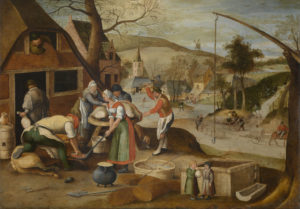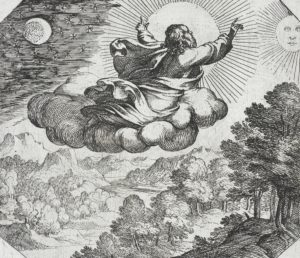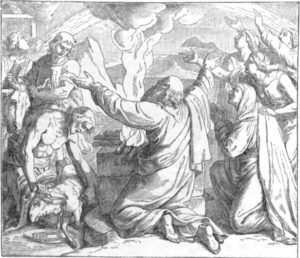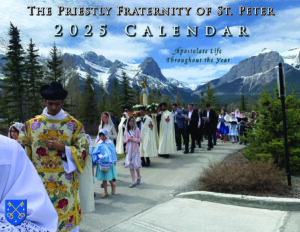September Embertide and the Christianizing of Eden
by Fr. William Rock, FSSP

According to the 1962 Liturgical Calendar of the Roman Rite, this Wednesday, Friday, and Saturday are Ember Days. The Ember Days are four sets of three days (Wednesday, Friday, and Saturday) which occur around the transitions of the natural seasons – winter, spring, summer, and autumn.
This year, the Autumn Equinox – when day and night are equal length and which astronomically marks the start of autumn, thus the end of summer, in the Northern Hemisphere – occurs this Wednesday, September 22nd, Ember Wednesday. Historically, the Ember Days were days of penance observed to give thanks to God for His blessings in the previous season and to ask for His blessings for the upcoming one. In 1962, Ember Wednesday and Saturday were days of fasting and partial abstinence – that is, one could take only one full meal and two little meals and meat only at the main meal. The two little meals, when added together, were not to equal a whole meal. Ember Friday, because it is a Friday, would have been a day of fasting and total abstinence, so no meat at all.
The Ember Days were also seen as days of prayer for those who were to be ordained, as ordinations were historically held on the Ember Saturdays. The practice of having ordinations on Ember Saturdays is still reflected in the Masses for the Ember Saturdays and the ordination rites themselves.
While there is no current canonical obligation to keep the upcoming Ember Days as days of penance, the reader is invited voluntarily to do so. Even if one cannot keep them as days of fasting and abstinence, the reader is encouraged to do some form of penance on these three days and to keep them with the same spirit and intentions as our Catholic forefathers – in thanksgiving for the blessings of the previous season, to ask God’s blessing for the upcoming one, and to pray for the clergy, particularly for those studying for the Priesthood. As part of the keeping of the Ember Days, seafood tempura is suggested – a Japanese food which, according to pious tradition, takes its name from the Latin name for the Ember Days, Quatuor Anni Tempora.

That the Latin Church in her liturgical traditions observes, in a way, the transition between the seasons should not be seen as odd or, even worse, pagan. A Catholic lives in this created material world just as much as a pagan does, and both have to live in and by its cycles. Marking the seasons is not distinctly pagan, or distinctly Catholic for that matter, but is simply human, part of the shared human experience. In fact, God intends that the heavenly bodies be used by man in such a way. According to the Book of Genesis, on the Fourth Day, “God said: Let there be lights made in the firmament of heaven, to divide the day and the night, and let them [the heavenly bodies] be for signs, and for seasons, and for days and years:” (Gen 1:14). With this knowledge, one may dare to say that the celebrating of the transitions of the natural seasons belongs most properly and rightly to those who worship the Creator, the True God, the Thrice Holy Trinity, rather than to the pagans. It is worth noting here that the Hebrew word translated as “seasons” can also mean “feasts.”1
Based on what has just been discussed and the requirements of the Natural Law for Divine Worship, it is the contention of this article that, in Eden, the worship of the Creator would have had an astronomical component. Planting and harvest festivals would not have arisen until after the Fall when, as a punishment, man was sentenced to work the land for his sustenance (Gen 3:17-19). Such a post-Fall development would be in keeping with man’s nature, his relationship with God, Who bestows all blessings, and fallen man’s relationship with material creation.
It is true that Man was created in a State of Grace and given a supernatural destiny,2 but he was to achieve this destiny within material creation. He was supernaturally elevated, but he was not, therefore, removed from the natural realm. Rather, he was to live in such a way so that he offered the material creation back to its Creator, acting as a mediator between God and the rest of material creation.

Man’s role of acting as a mediator between God and rest of material creation was not lost with the Fall, nor was the astronomical component of worship. The Hebrews, for example, were instructed to offer sacrifices every day, but to rest on the Seventh Day of the Week, the Sabbath, Saturday, to weekly mark God’s completion of Creation (see Gen 2:2-3; Exo 31:13-17). Several of the Psalms, such as Psalm 135 (according to the Vulgate numbering), hymn God for His works of Creation. Each New Moon was celebrated by the Hebrews with the blowing of the trumpet and marked the beginning of a new month (see Num 10:10). The date of the celebration of the Feast of Passover, and thus of Pentecost, was determined “from astronomical calculations.”3 Additionally, the Hebrew Feasts of Passover and Sukkot (the Feast of Tabernacles) had agricultural connections, Passover with the wheat harvest (see Exo 34:22) and Sukkot with the corn harvest (see Exo 23:16; 34:22). In this manner, the ceremonies of the Old Law incorporated not only the astronomical component of the worship of Eden, but also the post-Fall harvest festivals.
The keeping of the Ember Days, then, in a way returns the Christian to the most primitive type of the worship of God, to Edenic worship, as it were, to the worship of God grounded in and guided by the material creation, in particular the rhythm of the celestial bodies. Just as grace does not destroy nature, but rather builds upon and perfects nature,4 so too does the Catholic Church Christianize this primordial worship of God, elevating and incorporating it into worship of the New Law. This paradigm also explains why abstaining from meat on the Ember Days is especially fitting.

When God placed Man in the Garden, He told them: “behold I have given you every herb bearing seed upon the earth, and all trees that have in themselves seed of their own kind, to be your meat” (Gen 1:29). It was not until after the Fall and after the Flood, that God gave man animals as food: “And God blessed Noe and his sons. And he said to them: Increase, and multiply, and fill the earth. And let the fear and dread of you be upon all the beasts of the earth, and upon all the fowls of the air, and all that move upon the earth: all the fishes of the sea are delivered into your hand. And every thing that moveth, and liveth shall be meat for you: even as the green herbs have I delivered them all to you: saving that flesh with blood you shall not eat” (Gen 9:2-4).5 By abstaining from meat, man is behaving in a more Edenic, pre-diluvian, pre-flood way, a manner of acting which fits perfectly with the Edenic observance of the Ember Days.

But the Ember Days are not the only manner in which the Catholic Church incorporates the material creation into her worship of God. Catholicism, in particular traditional Catholicism, is – and the author can find no better word to describe it – earthy. The Roman Ritual includes blessings for fields, orchards, and vineyards; for seeds and seedlings, for herbs and flowers; for animals and their feed; for bees, for birds, for silkworms, against mice; for fountains and wells; for bonfires; for grapes, fruit, bread, butter, beer, and wine; for wedding chambers; the many sacramentals for expecting mothers, including a blessing of the mother and child. There is a whole ceremony of thanksgiving for the mother after childbirth. Turning to the Missal, there are votive orations for times of famines, for times of earthquakes, and for times of pestilence; for asking for rain, for asking for fine weather, for the repelling of storms. In the Divine Office, in the Times after Epiphany and Pentecost, the Sunday and weekday Vespers Hymns, when there are no feasts, progress day-by-day through the Days of Creation as expressed in Genesis. Again, the Catholic Church incorporates the material creation and our material nature into her worship of God, into her Liturgical Life, and, elevating all this, incorporates them into the rites of the New Law.

But it is not only Edenic worship which the Catholic Church incorporates and elevates, but also the worship of the Old Law, which itself incorporated post-Fall agricultural worship. The connections between the Jewish Passover and the Christian Holy Week and Easter and between the Jewish Pentecost and the Christian Pentecost are perhaps the most well-known (the dates of these Jewish Feasts, as noted above, being determined astronomically). But other Jewish Feasts are still marked in some manner by Christians. It has been noted that Ember Wednesday of September shares themes with Rosh Hashanah, the Jewish New Year.6 This year Rosh Hashanah was celebrated during the first week of September, just a few weeks prior to this year’s Ember Wednesday of September (although originally the New Year was celebrated around Passover, see Exo 12). The institutions of Yom Kippur, the Day of Atonement, and Sukkot, the Feast of Tabernacles, are read during the Mass of September’s Ember Saturday. This year, the Ember Saturday of September will be celebrated on September 25th, shortly following this year’s celebration of Yom Kippur, September 15th-16th. The celebration of Sukkot, September 20th-27th, overlaps with this year’s September Embertide.
So not only do the September Ember days mark the transition from summer to autumn, but they also Christianize the Jewish festivals of Rosh Hashanah, Yom Kippur, and Sukkot and that more-or-less coincidently with the Jewish feasts themselves. Other examples of the Liturgy of the New Law preserving and elevating elements of worship from the Old Law can be brought forward, but this will suffice for now.
Let us then, dear reader, as we worship God according to the Rites of the Latin Church, bear in mind that by them we are participating in an elevation and preservation of the astronomical worship of Eden, post-Fall agricultural worship, and the worship of the Old Law. And may all this particularly be kept in mind during this upcoming September Embertide, which you are invited to keep in the same spirit and practice as our Catholic forefathers.
Fr. William Rock, FSSP was ordained in the fall of 2019 and is currently assigned to Regina Caeli Parish in Houston, TX.
1. Strong’s Dictionary, H4150.
2. Ott, Ludwig, Fundamentals of Catholic Dogma. Baronius Press, 2018, p. 113.
3. Catholic Encyclopedia, s.v. “Pasch or Passover.”
4. See S.T. I, q. 1, a. 8, ad 2.
5. See Dom Guéranger’s The Liturgical Year – Lent (History of Lent).
6. Kunitz-Dick, Alisa. Audi, Israël: Jewish Feasts in the Propers of the Traditional Roman Rite
September 20, 2021








